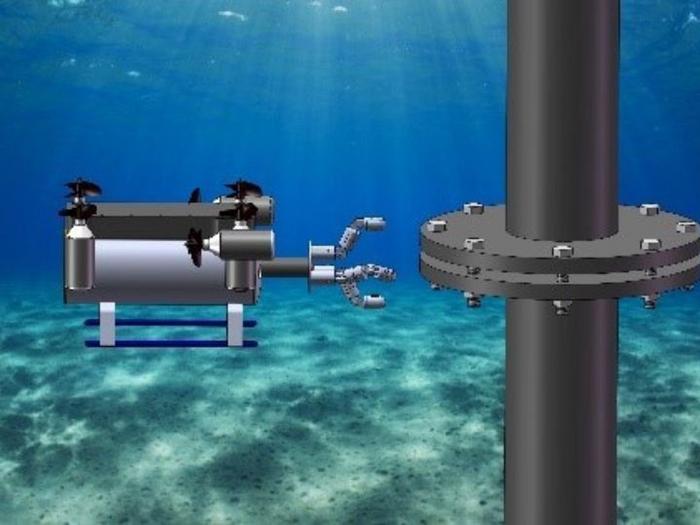Autonomous robot for subsea oil and gas pipeline inspection

SmartTouch technology rendering
Credit: University of Houston
… being developed at University of Houston.
With an increasing number of severe accidents in the global oil and gas industry caused by damaged pipelines, University of Houston researchers are developing an autonomous robot to identify potential pipeline leaks and structural failures during subsea inspections. The transformative technology will make the inspection process far safer and more cost effective, while also protecting subsea environments from disaster.
Thousands of oil spills occur in U.S. waters each year for a variety of reasons. While most are small, spilled crude oil can still cause damage to sensitive areas such as beaches, mangroves and wetlands. When larger spills happen, pipelines are often the culprit. From 1964 through 2015, a total of 514 offshore pipeline–related oil spills were recorded, 20 of which incurred spill volumes of more than 1,000 barrels, according to the Bureau of Ocean Energy Management.
The timely inspection of subsea infrastructure, especially pipelines and offshore wells, is the key to preventing such disasters. However, current inspection techniques often require a well-trained human diver and substantial time and money. The challenges are exacerbated if the inspection target is deep underwater.
The SmartTouch technology now in development at UH consists of Remote Operated Vehicles (ROVs) equipped with multiple stress wave-based smart touch sensors, video cameras and scanning sonars that can swim along a subsea pipeline to inspect flange bolts – bolted connections have accelerated the rate of pipeline accidents that result in leakage, according to the Bureau of Safety and Environmental Enforcement (BSEE).
The BSEE is funding the project with a $960,493 grant to UH researchers Zheng Chen, Bill D. Cook Assistant Professor of Mechanical Engineering and Gangbing Song, John and Rebecca Moores Professor of Mechanical Engineering, who are working in collaboration with Oceaneering International and Chevron.
“By automating the inspection process with this state-of-the art robotic technology, we can dramatically reduce the cost and risk of these important subsea inspections which will lead to safer operations of offshore oil and gas pipelines as less intervention from human divers will be needed,” said Chen, noting that a prototype of the ROV has been tested in his lab and in Galveston Bay. The experiments demonstrated the feasibility of the proposed approach for inspecting the looseness of subsea bolted connections. Preliminary studies were funded by UH’s Subsea Systems Institute.
Oil and gas pipelines fail for a variety of reasons including equipment malfunctions, corrosion, weather and other natural causes, or vessel-related accidents which account for most large leaks. Toxic and corrosive fluids leaked from a damaged pipe can lead to devastating environmental pollution.
“Corrosion is responsible for most small leaks, but the impacts can still be devastating to the environment. Therefore, our technology will be highly accurate in monitoring corrosion and will also help mitigate the chances of pipeline failure from other factors,” said co-principal investigator Gangbing Song, who has conducted significant research in piezoelectric-based structural health monitoring. His prior research efforts include numerous damage detection applications, such as crack detection, hydration monitoring, debonding and other structural anomalies.
The UH researchers are collaborating with Oceaneering International, an industrial leader in ROV development, non-destructive testing and inspections, engineering and project management, and surveying and mapping services. Additionally, Chevron, a major oil and gas operator, will evaluate the technology’s future commercialization.
The SmartTouch sensing solution will open the doors for inspection of other kinds of subsea structures, according to the researchers, by forming a design template for future robotic technologies.
“Ultimately, the project will push the boundaries of what can be accomplished by integrating robotics and structural health monitoring technologies. With proper implementation, the rate of subsea pipeline failure and related accidents will decrease, and subsea operations will be free to expand at faster rate than before,” added Chen.
Media Contact
Chris Stipes
University of Houston
cdstipes@uh.edu
Office: 713-743-8186
All latest news from the category: Information Technology
Here you can find a summary of innovations in the fields of information and data processing and up-to-date developments on IT equipment and hardware.
This area covers topics such as IT services, IT architectures, IT management and telecommunications.
Newest articles

Innovative 3D printed scaffolds offer new hope for bone healing
Researchers at the Institute for Bioengineering of Catalonia have developed novel 3D printed PLA-CaP scaffolds that promote blood vessel formation, ensuring better healing and regeneration of bone tissue. Bone is…

The surprising role of gut infection in Alzheimer’s disease
ASU- and Banner Alzheimer’s Institute-led study implicates link between a common virus and the disease, which travels from the gut to the brain and may be a target for antiviral…

Molecular gardening: New enzymes discovered for protein modification pruning
How deubiquitinases USP53 and USP54 cleave long polyubiquitin chains and how the former is linked to liver disease in children. Deubiquitinases (DUBs) are enzymes used by cells to trim protein…



